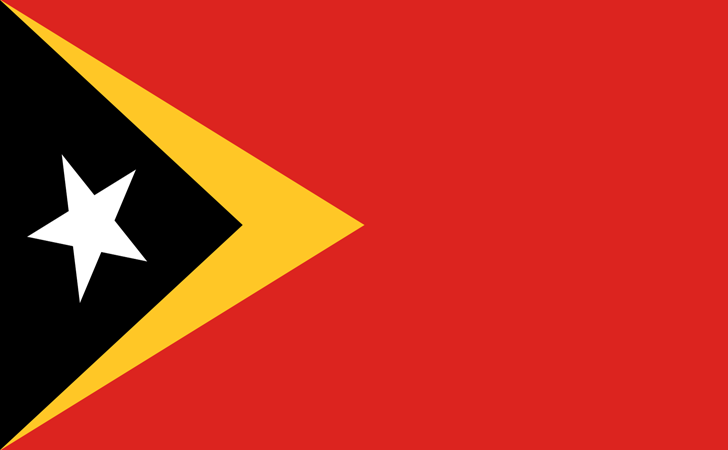
On May 20, 2002, East Timor gained full independence and a new national flag was approved. Prior to this, subsequent Indonesia’s extraction in 1999, East Timor was managed by the UN, and the UN flag hovered over it. East Timor flag features black, yellow, red colors and white stars. The black signifies more than four periods of colonial repression, the yellow the fight for independence, and the red the sorrow of the East Timorese people. The white star represents hope for the future.
The flag is founded on a design used by the Revolutionary Front of Independent East Timor (Fretilin), the main assemblage opposing Indonesia’s seizure of East Timor in 1975–76. Flag of East Timor comprise of a striped red-yellow-red field with a black canton along the hoist deportment a white star.
East Timor is a republic in Maritime Southeast Asia. The nation developed to a colony of Portugal in the 16th century, and was recognized as Portuguese Timor until it attained independence on November 28, 1975. However, this independence was short-lived, as Indonesia attacked and occupied East Timor only nine days later. For periods, East Timor experienced violence as nationalist groups fought with the Indonesian military. In 1999, with the assistance of the United Nations, East Timor enthused closer to becoming an independent country over as Indonesia relinquished control of the territory. On May 20, 2002, East Timor became the 21st century’s first sovereign state.
The national flag of East Timor was first accepted in 1975 during the country's short-lived nine-day period of independence. On April 1998, a new flag was recommended for the country during the East Timorese National Agreement, and its design was beforehand used by the National Council of Timorese Resistance. However, use of this flag was on provision. When East Timor attained its independence again in 2002, the flag first presented in 1975 was readopted as the country's national flag.
The flag of East Timor landscapes a red field with a black isosceles triangle on the winch side of the flag. This triangle is overlaid on a larger yellow triangle, which is also built on the hoist side of the flag and has an elevation that is half the length of the flag. The black triangle structures a white star with five points.
Every color and symbol in East Timor’s flag has meaning. The red color represents the country’s struggle for independence, while the yellow triangle is supposed to signify the traces of colonialism in the country's history. The black color denotes the country's "obscurantism that needs to be overcome," and the white star signifies peace and managerial light.
Situated in the Southeast Asia continent, it features the eastern half of the island, sharing nearby islands with Jaco, Atauro and Oecusse, an exclave on the northwestern side surrounded by Indonesian West Timor. Australia is the country's southern neighbor, unglued by the Timor Sea. With the population of 13 lacs, it has the population density of 81.51 sq. Km.
East Timor has framework of a unitary semi-presidential representative democratic republic. Here, the Prime Minister of East Timor is consider head of government and thus exercises the functions of head of state.
The official language of East Timor is Portuguese and Tetun and the currency is USD. East Timor comprises of two letters East Timor code i.e. AL and its three letters East Timor code is ALB and in digits it is 626. The calling code is +355 and the UTC i.e. standard time followed in East Timor is UTC +02 hours.
Being a unitary semi-presidential republic is itself a 24th province. Therefore, it has no provinces and states.
| Country | Timor-Leste |
|---|---|
| Continent | Asia |
| Official languages | Tetum, Portuguese |
| Capital | Dili |
| Currency | United States dollar $ (USD) |
| CET | UTC+09:00 |
|---|---|
| CEST | UTC+09:00 |
| Internet TLD | TL |
|---|---|
| Three-letter country code | TLS |
| Three-digit country code | 626 |
| Calling code | +670 |